How to Make Macarons (French Macaroons) - Easy Recipe w/Photos
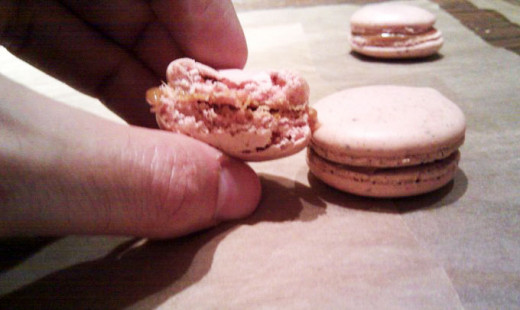
Are you fan of the French macaron (sometimes spelled macaroon in English)? I'm not talking about heavy, lumpy coconut macaroons; I'm talking about the light sandwich pastry with a filling in between, the upscale Oreo. If you've had a French macaroon and wanted to know how to make them yourself, here's how to do it.
Despite it having the reputation of being a tough thing to make, I've found the technique to use that really never fails. Just follow these directions carefully! You won't be disappointed. This really is the simplest, easiest way of making these delectable little treats.
Interesting facts:
- this recipe is gluten-free, so safe for those who must avoid gluten
- there is no grain (provided your powdered sugar doesn't have corn starch), so French macaroons are kosher for Passover
- depending on the size and filling, macarons have between 45 and 150 calories apiece
Assemble the ingredients
When it comes to pastry, fairly precise measurements are important. This recipe uses a technique (the Italian meringue, or au sucre cuit, method) that is more failsafe than the traditional French whipped egg whites technique, but it's still possible to mess up. If you don't have a kitchen scale, then try using my volume/number based approximations, but if you do, then stick to those approximate values throughout.
- 200g almond meal (approx 2 cups)
- 200g powdered sugar (approx 1 3/4 cups)
- 75g egg whites (approx 2 egg whites from large eggs)
- (another) 75g egg whites (approx 2 egg whites from large eggs)
- 200g regular sugar (approx 1 cup)
- 50g water (approx 1/5 of a cup)
- food coloring (optional)
- filling (ganache, buttercream, jam, frosting, etc. - whatever you like!)
- sturdy cookie (baking) sheet (one that won't warp in the oven)
- standing mixer (like a Kitchen Aid) with whisk attachment
- food processor
- pastry bag (or gallon-sized freezer bag with corner cut off)
- kitchen thermometer (not absolutely necessary, but highly recommended)
- a big bowl
- parchment paper - I use If You Care organic parchment paper, which contains no quilon (a chrome-based chemical) as you would find in standard parchment paper
I do not recommend using silpats; due to the thicker silicone, the bottoms never cook through completely, and your macarons will stick.
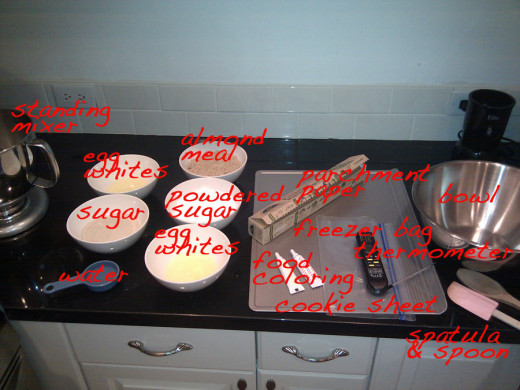
1. Put egg whites in your mixer & preheat your oven
Put one of your 75g egg white portions in your mixer, to allow it to warm up to room temperature. If your egg whites are already at room temperature, then you can skip this step (or, rather, just do it later)
If it takes some time for your oven to heat up, you might as well start preheating now: you'll want to set the temperature to 320F (or 160C).
2. Blend almond meal and powdered sugar
Put your 200g of almond meal and 200g of powdered sugar in a food processor. Blend until fully mixed and without any lumps (consider sifting if you can't get all the lumps out).
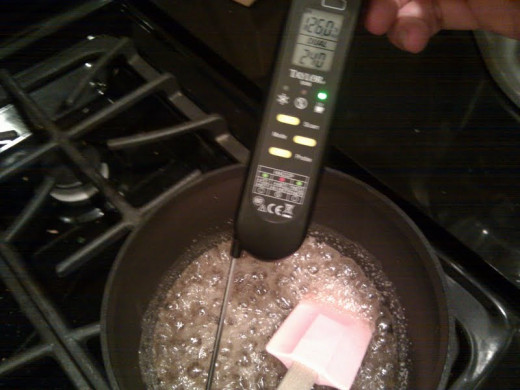
3. Start cooking sugar and water
Put the 200g of regular sugar and 50g of water in a small pan and begin heating it. When it dissolves and starts to bubble, start checking the temperature. The goal is to get to 245F (118C).
If you don't have a thermometer, cook until it is bubbly and frothy.
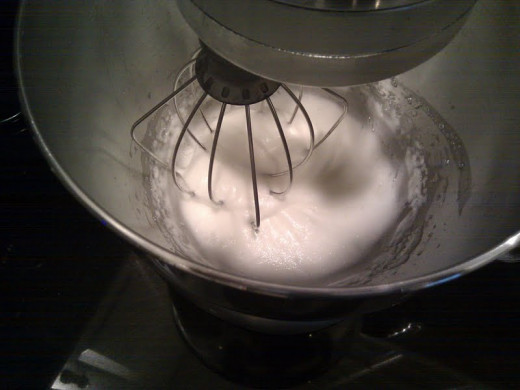
4. Start whisking egg whites
The egg whites from step 1 should be at room temperature by now. Begin whisking them in your standing mixer until they achieve stiff peaks. As soon as you have reached the stiff peak stage, stop whisking! (Don't overbeat your egg whites)
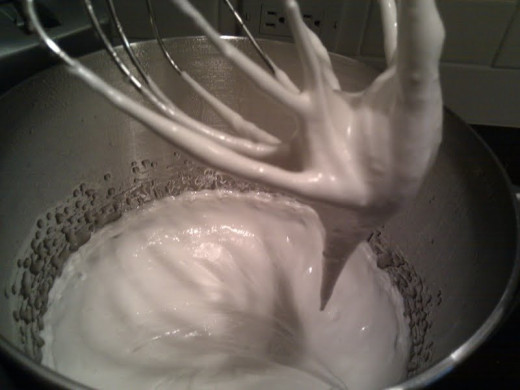
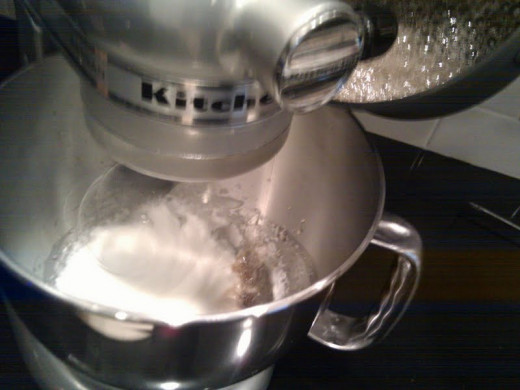
5. Pour in melted sugar into whipped egg whites
Lower your mixer to "low" and slowly pour in your melted sugar (at 245F/118C) in a thin stream while the eggs are being whipped. Once all the sugar is in, raise the speed to "high" and let it whip for another 2-3 minutes. The whipped egg whites will go from a pale, translucent white to a brilliantly shiny, glossy, bright white color and will develop a creamy texture (it will become a meringue). It is very, very much like marshmallow topping, if you're familiar with this ice cream sundae topping.
The meringue is done when you pull out the whisk and turn it sideways, and a "bird's beak" of meringue dangles off the tip of the whisk (see right).
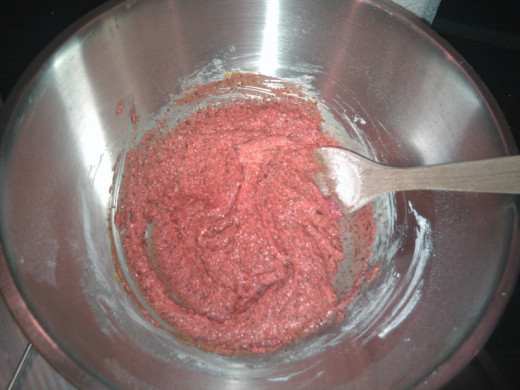
6. Mix egg whites into almond/sugar mixture
Mix the other 75g of unbeaten egg whites into your almond meal/powdered sugar mixture. It will result in a fairly stiff batter.
This is the time to add any food coloring if you wanted to. Go heavy on the dye, since, after adding the meringue and baking, the macarons will be much lighter in color than the batter now.
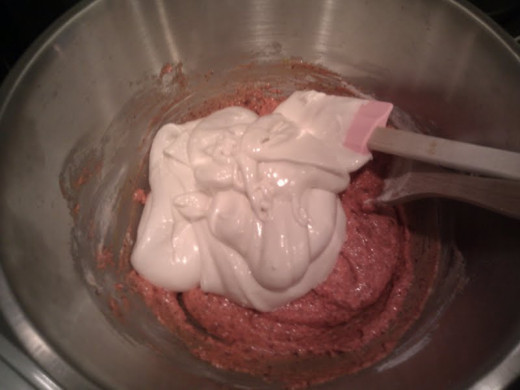
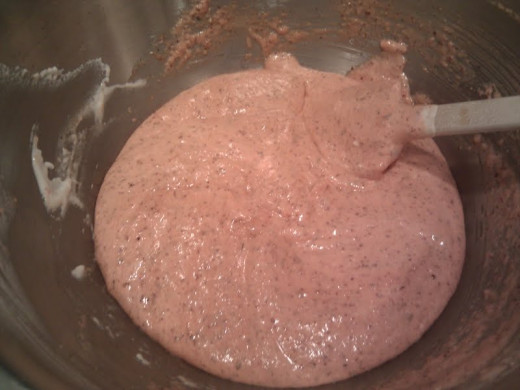
7. Gently fold in the meringue into the batter
In a step the French call macaronnage, gently fold in the meringue into the batter. Do not mix aggressively; you do not want to deflate the meringue you've made.
What I've found works best is to take a small portion of the meringue, and fold that into the batter first. This will help "liquefy" the batter somewhat, making it less stiff and less resistant to folding in with the rest of the meringue. Then, add the rest of your meringue to this softened batter, gently folding it in. I've found that about 20-30 folds incorporates the meringue into the batter.
The resulting batter should have the texture of lava--when you pull your spatula/spoon out of the batter, a ribbon of batter drips back into the bowl and slowly reincorporates into the batter.
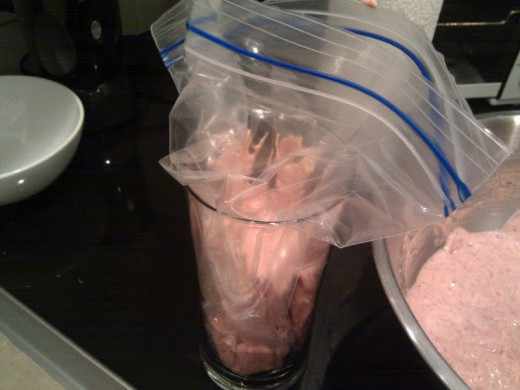
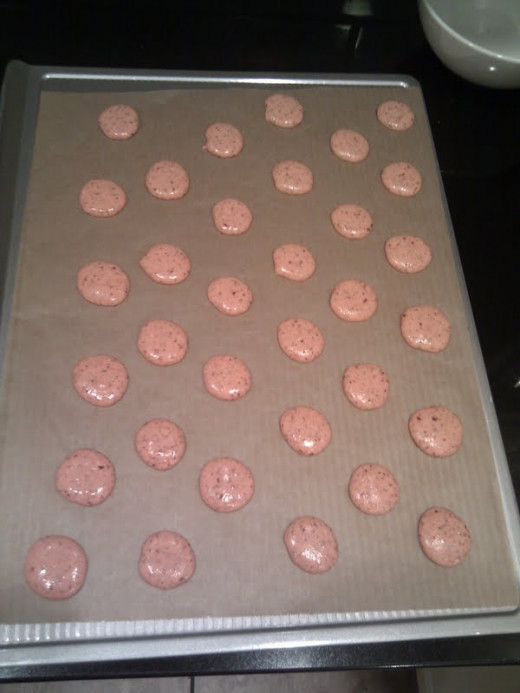
8. Pipe the batter onto your parchment paper
Into either a piping bag, or a large clean plastic bag with the corner cut off, fill with your batter about halfway. It's a good idea to put your bag into a tall glass, open it up, and fill it with a spoon or spatula.
Put parchment paper onto your cookie sheet, and pipe small circles of batter (maybe 1 1/2" in/4 cm diameter), leaving plenty of room between batter drops.
When done with a sheet, pick up the cookie sheet and drop it on your counter carefully but forcefully, to help the batter spread a little bit and for any air bubbles to pop. This is an optional step, but if done right, it will lead to better-shaped macaron shells.
Most recipes call for the pre-baked, piped macarons to "rest" for at least an hour before going in the oven. With the Italian meringue (au sucre cuit method), this isn't crucial, but it's absolutely fine to pipe and then wait for a while before baking--it's very stable.
9. Bake
Bake for 15 minutes in a 320F (160C) oven. If you have a convection oven, 15 minutes is good. If you don't have a convection oven, rotate your cookie sheet once halfway through to make sure the baking is even.
Pro tip! Put an empty baking sheet or two below the cookie sheet you're using, to deflect any direct heat from the bottom. Too much direct heat from the heat source at the bottom can cause the macarons to build up into mounds that crack (like mini volcanoes) instead of the flat, unbroken tops they should have.
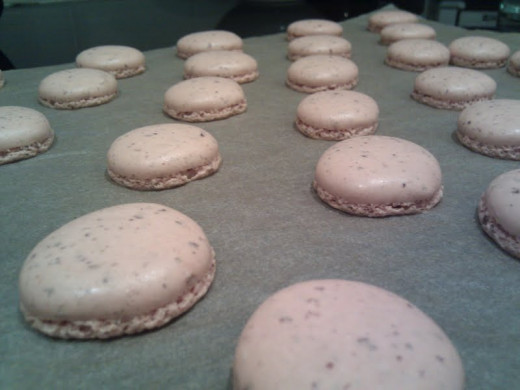
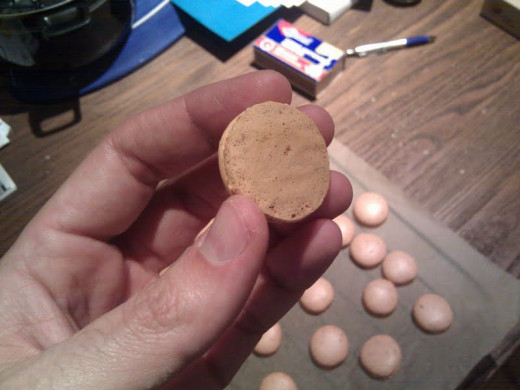
10. Finish off!
Pull your macarons out of the oven; they should be able to pull off your parchment paper without too much effort and with almost no residue. If your macarons are sticking to the paper or leaving behind quite a bit of the dough, then bake them a bit longer--they're underdone.
Allow them to cool, and pair similarly-sized macaron shells together.
Spread a bit of filling (the recipe for the caramelized white chocolate ganache I used is beneath the picture below). You can put ganache, jam, jelly, buttercream, icing, or anything you like, really, that will glue together the two halves and provide a complementary flavor to your sweet, almondy shells.
If you overcooked your macarons and they are hard (like a meringue cookie) instead of soft inside, don't worry! Use a filling with some moisture, like a wet ganache or jam, and wait a couple of days. The moisture from the filling will rehydrate your macarons and make them soft inside again. (Note that buttercream is not recommended in this case, since buttercream has very little moisture)

Caramelized white chocolate ganache
This is easy to make and so delicious!
You'll need:
- high-quality white chocolate (at least 30% cocoa butter) - avoid "white baking chips" or anything that doesn't explicitly say "white chocolate"
- heavy (double) cream, equal in weight to 1/4 the weight of your white chocolate
- a dash of sea salt (if you want a salted caramel flavor)
Preheat your oven to 250F (120C). Chop up your white chocolate and spread it in a deep baking sheet (not completely flat, since the chocolate is going to liquefy and run!). Place in the oven.
Every 10 minutes, take the sheet out of the oven and mix with a silicone spatula. The liquid will continue to darken, and eventually take on a light-brown/caramel color. The color may be uneven and the texture similar to goat cheese - that's OK. After about 5 cycles (about 50 minutes), heat the cream to boiling and add both it and the melted, caramelized white chocolate to a metal bowl.
Whisk aggressively for at least 5 minutes, until you have a creamy ganache. Cool in the refrigerator until it's room temperature (about 10-15 minutes) before attempting to use.